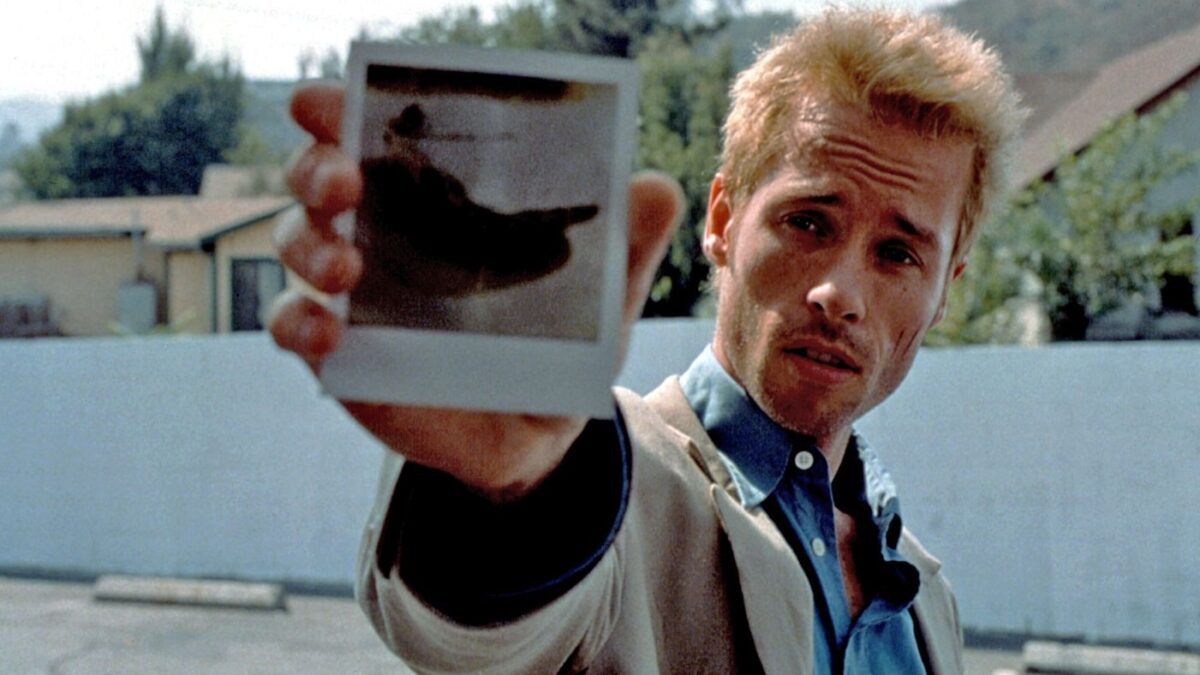In this section of our Colossus Movie Guide for Memento, we look at important motifs that help us understand the film.
Cast
- Guy Pearce – Leonard Shelby
- Carrie-Anne Moss – Natalie
- Joe Pantoliano – John Edward “Teddy” Gammell
- Mark Boone Junior – Burt
- Russ Fega – Waiter
- Jorja Fox – Catherine Shelby
- Stephen Tobolowsky – Samuel R. “Sammy” Jankis
- Harriet Sansom Harris – Mrs. Jankis
- Thomas Lennon – Doctor
- Callum Keith Rennie – Dodd
- Christopher Nolan – Writer and director
Important motifs in Memento
Polaroid Photographs
Polaroid photographs act as a tangible manifestation of Leonard’s fleeting memories in Memento. He relies on these images to recall the people in his life and his interactions with them. Each Polaroid is annotated with key details, providing Leonard a semblance of control over his fractured reality. Yet, these photographs also symbolize the unreliability of memory. The context and significance of these captured moments are dictated by the notes Leonard scribbles on them, highlighting how subjective and manipulable memories can be.
For instance, the photograph of Teddy with the note “Don’t believe his lies” dramatically impacts Leonard’s perception of Teddy, causing him to mistrust Teddy despite his seemingly helpful actions. The Polaroids, thus, not only represent Leonard’s attempts to retain his past but also his manipulation of his own reality.
Tattoos
Leonard’s tattoos in Memento serve multiple roles. They are both physical reminders of his mission and symbolic representations of his guilt, regret, and self-deception. Each tattoo represents a piece of information that Leonard deems critical to his quest for revenge. The most significant among these is the tattoo across his chest, “John G. raped and murdered my wife.” This message epitomizes Leonard’s motivation, serving as a permanent, visceral reminder of his purpose.
However, as the narrative unfolds, we realize that these tattoos, like the Polaroids, are not necessarily truthful. They are subject to Leonard’s interpretation and manipulation. When confronted with the truth about his wife’s death and his vengeful mission, Leonard chooses to create a new “John G,” implying he can manipulate his tattoos, his only reliable source of memory, to fit his desired narrative.
Mirrors
Mirrors frequently appear throughout Memento, playing a crucial role in communicating Leonard’s internal struggles. Mirrors often reflect Leonard examining his tattoos, symbolizing his attempt to understand himself and his past through these permanent inscriptions. However, as mirrors only provide a reflection—a reversed, possibly distorted image—they also echo the theme of distortion and reversal prevalent in the movie.
Mirrors often serve as a tool for self-confrontation in cinema. For Leonard, his reflections force him to face the reality of his condition and its implications. Yet, the fact that he often views himself through these mirrors while interpreting his tattoos also suggests a level of self-deception.
Repetition
Repetition is a recurrent motif in Memento, mirroring Leonard’s experience of living the same moments repeatedly due to his memory condition. This motif is present in the narrative structure, with scenes frequently repeating from different perspectives, and in Leonard’s routine of self-identification and mission explanation.
The constant repetition highlights Leonard’s trapped state, as he is caught in a loop of forgetfulness and rediscovery. It also underlines the cyclical nature of his quest for revenge, which, as revealed in the end, is a self-perpetuating cycle fueled by manipulated memories.
The Broken Window
The broken window in Leonard’s car is a subtle yet significant motif in Memento. It is a physical reminder of Leonard’s violent past and the chaotic world he navigates. The broken window signifies Leonard’s fractured perception of reality, mirroring his broken memory. It serves as a metaphor for his shattered life and identity, which he attempts to piece together through his fragmented recollections.
Moreover, the broken window also symbolizes the destructive impact of Leonard’s obsession with revenge. Just as the car window was shattered as a result of Leonard’s pursuit of a supposed assailant, his life and identity have been shattered by his relentless quest for vengeance. Every time Leonard drives his car, he is reminded of his violent quest, reflecting his inability to escape from his past.
Interestingly, Leonard does not fix the window, just as he does not seek to fix or come to terms with his past. He chooses to live with these reminders of his tragedy, reinforcing his decision to manipulate his memories and maintain his self-image as the aggrieved avenger.
Share your thoughts
Are there more motifs you think should be part of the Colossus Movie Guide for Memento? Leave your thoughts below and we’ll consider them for the guide.

